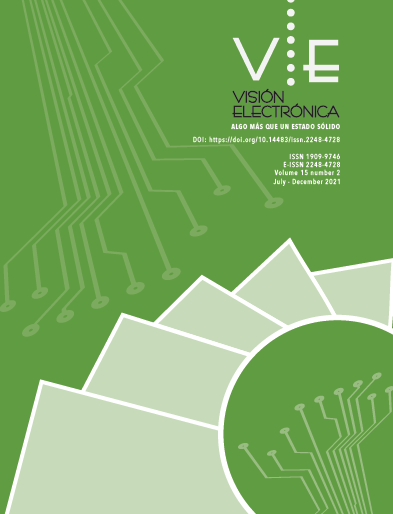Publicado:
2023-03-03Número:
Vol. 17 Núm. 1 (2023)Sección:
Visión de CasoSimulación del modelo de actuador serial elástico para prótesis Tobillo-Pie en Matlab
Serial Elastic Actuator Model for Ankle-Foot Prosthesis Matlab Simulation
Palabras clave:
Serial Elastic Actuator (SEA), Ankle Foot Prosthesis, Gait Cycle (en).Palabras clave:
Actuador elástico en serie (SEA), Prótesis de tobillo y pie, Ciclo de marcha (es).Descargas
Resumen (es)
El conjunto tobillo-pie desempeña un papel muy importante para el movimiento humano, como caminar o correr, ya que proporciona apoyo vertical y propulsión de la progresión de la marcha humana mediante la extensión y contracción muscular. Se han desarrollado muchos diseños para replicar la función de la marcha normal, perdida por lesiones o enfermedades que afectan la extremidad debajo de la rodilla [1]. La rehabilitación motora se ha convertido en un campo de amplio interés, ya que en Colombia hay gran cantidad de casos de personas con lesiones o mutilaciones en sus miembros o en otros casos por accidentes cerebrovasculares y daño medular que provocan parálisis o cualquier tipo de discapacidad. [2], [3]. Este artículo muestra el proceso para obtener el modelo del mecanismo SEA en Matlab, vinculando el VR-World de Simulink con un modelo 3D en Solidworks de la prótesis para validarlo y finalmente verificar las curvas características de la marcha normal a 1,5 m / s con esta prótesis SEA.
Resumen (en)
The ankle - foot set plays a very important role for human displacement, such as walking or running, giving vertical support and propulsion to the human walking progression by using the muscle extension and contraction. Many designs have been developed to replicate the function of normal gait, lost by injuries or diseases affecting the limb below the knee [1]. Motor rehabilitation has become a field of growing interest, due to the large number of cases of people with injuries or mutilation in its members or in other cases by cerebrovascular accidents and spinal cord damage that cause paralysis or any kind of disability. [2], [3]. This paper shows the process to get the model of SEA mechanism in Matlab, linking VR-World of Simulink from 3D Solidworks Model to test the model and finally checking the characteristic curves of normal gait to 1.5 m/s with this SEA prosthesis.
Referencias
S. K. Au, J. Weber, and H. Herr, "Biomechanical design of a powered ankle-foot prosthesis," in Rehabilitation Robotics, 2007. ICORR 2007. IEEE 10th International Conference on, 2007, pp. 298–303.
E. J. Rouse, L. M. Mooney, E. C. Martinez-Villalpando, and H. M. Herr, "Clutchable Series-Elastic Actuator: Design of a Robotic Knee Prosthesis for Minimum Energy Consumption," in 13th International Conference on Rehabilitation Robotics, ICORR 2013.
S. K. Au and H. M. Herr, "Powered ankle-foot prosthesis," IEEE Robotics & Automation Magazine, vol. 15, no. 3, pp. 2008.
D. Dong, W. Ge, S. Liu, F. Xia, and Y. Sun, "Design and optimization of a powered ankle-foot prosthesis using a geared five-bar spring mechanism," International Journal of Advanced Robotic Systems, vol. 14, no. 3, p. 1729881417704545, 2017.
A. K. LaPre, R. D. Wedge, B. R. Umberger, and F. C. Sup, "Preliminary study of a robotic foot-ankle prosthesis with active alignment," in Rehabilitation Robotics (ICORR), 2017 International Conference on, 2017, pp. 1299–1304.
M. LeBlanc, "Give hope-give a hand. The LN-4 Prosthetic Hand," 2014, 2008.
D. Dong, W. Ge, S. Liu, F. Xia, and Y. Sun, "Design and optimization of a powered ankle-foot prosthesis using a geared five-bar spring mechanism," International Journal of Advanced Robotic Systems, vol. 14, no. 3, p. 1729881417704545, 2017.
S. K. Au, J. Weber, and H. Herr, "Powered ankle-foot prosthesis improves walking metabolic economy," IEEE Transactions on Robotics, vol. 25, no. 1, pp. 51–66, 2009.
A. D. Kuo, "The six determinants of gait and the inverted pendulum analogy: A dynamic walking perspective," Human movement science, vol. 26, no. 4, pp. 617–656, 2007.
M. M. Rodgers, "Dynamic biomechanics of the normal foot and ankle during walking and running," Physical therapy, vol. 68, no. 12, pp. 1822–1830, 1988.
T. T. Nguyen, T.-P. Dao, and S.-C. Huang, "Bio-mechanical design of a novel six dof compliant prosthetic ankle-foot 2.0 for rehabilitation of amputee," in ASME 2017 International Design Engineering Technical Conferences and Computers and Information in Engineering Conference, 2017, pp. V05AT08A013–V05AT08A013.
J. Alves, E. Seabra, C. Ferreira, C. P. Santos, and L. P. Reis, "Design and dynamic modelling of an ankle-foot prosthesis for humanoid robot," in Autonomous Robot Systems and Competitions (ICARSC), 2017 IEEE International Conference on, 2017, pp. 128–133.
L. Ren, R. K. Jones, and D. Howard, "Predictive modelling of human walking over a complete gait cycle," Journal of biomechanics, vol. 40, no. 7, pp. 1567–1574, 2007.
S. K. Au and H. Herr, "Initial experimental study on dynamic interaction between an amputee and a powered ankle-foot prosthesis," in Workshop on dynamic walking: Mechanics and control of human and robot locomotion, 2006, p. 1.
S. K. Au, H. Herr, J. Weber, and E. C. Martinez-Villalpando, "Powered ankle-foot prosthesis for the improvement of amputee ambulation," in Engineering in Medicine and Biology Society, 2007. EMBS 2007. 29th Annual International Conference of the IEEE, 2007, pp. 3020–3026.
M. Grimmer, M. Eslamy, S. Gliech, and A. Seyfarth, "A comparison of parallel- and series elastic elements in an actuator for mimicking human ankle joint in walking and running," in 2012 IEEE International Conference on Robotics and Automation, 2012, pp. 2463-2470.
S. Shashikant, "Mechanical Leg," [Online]. Available: https://grabcad.com/library/mechanical-leg-2.
G. Rouleau, "From SolidWorks to SimMechanics Posted in July 10, 2014," Simulink & Model-Based Design, 2014. [Online]. Available: https://blogs.mathworks.com/simulink/2014/07/10/from-solidworks-to-simmechanics/
M. F. Eilenberg, H. Geyer, and H. Herr, "Control of a powered ankle–foot prosthesis based on a neuromuscular model," IEEE transactions on neural systems and rehabilitation engineering, vol. 18, no. 2, pp. 164-173, 2010.
Cómo citar
APA
ACM
ACS
ABNT
Chicago
Harvard
IEEE
MLA
Turabian
Vancouver
Descargar cita
Visitas
Descargas
Licencia
Derechos de autor 2023 Visión electrónica

Esta obra está bajo una licencia internacional Creative Commons Atribución-NoComercial 4.0.
.png)
atribución- no comercial 4.0 International






.jpg)





